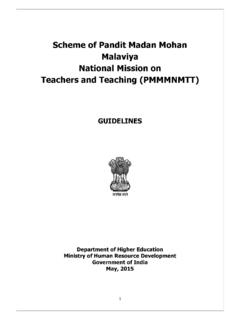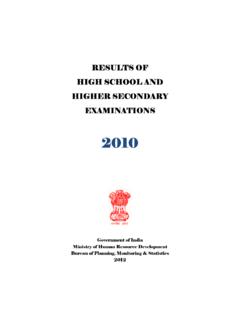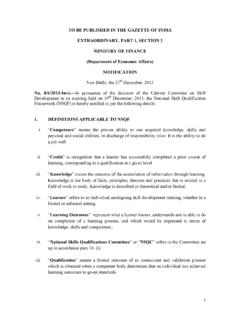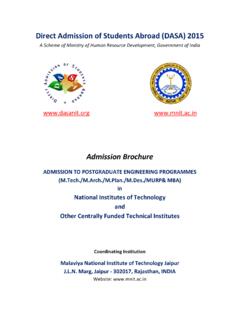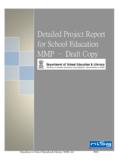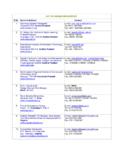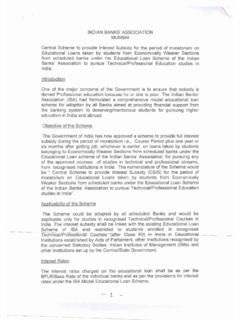Transcription of National Policy on Information and Communication ...
1 Last revision: 23 March, 2012 National Policy on Information and Communication technology (ICT) In School Education Department of School Education and Literacy Ministry of Human Resource Development Government of India 2012 Contents Page No. 1. Preamble 2. Vision, Mission and Policy Goals 3. What is ICT? 4. ICT in School Education Challenges and issues ICT Literacy and Competency enhancement ICT enabled teaching learning processes Elective Courses at Higher Secondary Level ICT for Skill Development (Vocational and Job oriented areas of general Education) ICT for Children with Special Needs ICT for Open and Distance Learning 5.
2 ICT for School Management Automated and ICT managed school processes School Management Information System 6. ICT Infrastructure Hardware Network and Connectivity Software Enabling Infrastructure 7. Digital Resources Digital Content and Resources Development of content Sharing and Dissemination of Digital Content Role of School Library 8. Capacity Building Capacity building of In-Service Teachers Capacity building through Pre service Teacher Education Capacity building of School Heads Capacity building of State / District Education Department Personnel 9.
3 Implementing and Managing the Policy Programme Monitoring and Evaluation Group (PM & EG) Inter-ministerial Group National and State level Agencies Role of the States Programme of Action Advisory Group Norms, Standards and Procedures Models for ICT Infrastructure Regulatory Measures Incentives 10. Financing and Sustainability 11. Monitoring and Evaluation Monitoring Evaluation Sharing of Results and Findings Policy Review 1. Preamble The National Policy on Education 1986, as modified in 1992, stressed the need to employ educational technology to improve the quality of education.
4 The Policy statement led to two major centrally sponsored schemes, namely, Educational technology (ET) and Computer Literacy and Studies in Schools (CLASS) paving the way for a more comprehensive centrally sponsored scheme Information and Communication technology @ Schools in 2004. Educational technology also found a significant place in another scheme on upgradation of science education. The significant role ICT can playin school education has also been highlighted in the National Curriculum Framework 2005 (NCF) 2005. Use of ICT for quality improvement also figures in Government of India's flagship programme on education, Sarva Shiksha Abhiyan (SSA).
5 Again, ICT has figured comprehensively in the norm of schooling recommended by the Central Advisory Board of Education (CABE), in its report on Universal Secondary Education, in 2005. With the convergence of technologies, it has become imperative to take a comprehensive look at all possible Information and Communication technologies for improving school education in the country. The comprehensive choice of ICT for holistic development of education can be built only on a sound Policy . The initiative of ICT Policy in School Education is inspired by the tremendous potential of ICT for enhancing outreach and improving quality of education.
6 This Policy endeavours to provide guidelines to assist the States in optimizing the use of ICT in school education within a National Policy framework. 2. Vision, Mission and Policy Goals Vision The ICT Policy in School Education aims at preparing youth to participate creatively in the establishment, sustenance and growth of a knowledge society leading to all round socio-economic development of the nation and global competitiveness. Mission To devise, catalyse, support and sustain ICT and ICT enabled activities and processes in order to improve access, quality and efficiency in the school system Policy Goals To achieve the above, the ICT Policy in School Education will endeavour to.
7 Create an environment to develop a community knowledgeable about ICT an ICT literate community which can deploy, utilise, benefit from ICT and contribute to nation building an environment of collaboration, cooperation and sharing, conducive to the creation of a demand for optimal utilisation of and optimum returns on the potentials of ICT in education Promote universal, equitable, open and free access to a state of the art ICT and ICT enabled tools and resources to all students and teachers development of local and localised quality content and to enable students and teachers to partner in the development and critical use of shared digital resources development of professional networks of teachers, resource persons and schools to catalyse and support resource sharing, upgradation, and continuing education of teachers; guidance, counselling and academic support to students.
8 And resource sharing, management and networking of school managers and administrators, resulting in improved efficiencies in the schooling process research, evaluation and experimentation in ICT tools and ICT enabled practices in order to inform, guide and utilise the potentials of ICT in school education a critical understanding of ICT, its benefits, dangers and limitations Motivate and enable wider participation of all sections of society in strengthening the school education process through appropriate utilisation of ICT 3. What is ICT? Information and Communication Technologies are defined as all devices, tools, content, resources, forums, and services, digital and those that can be converted into or delivered through digital forms, which can be deployed for realising the goals of teaching learning, enhancing access to and reach of resources, building of capacities, as well as management of the educational system.
9 These will not only include hardware devices connected to computers, and software applications, but also interactive digital content, internet and other satellite Communication devices, radio and television services, web based content repositories, interactive forums, learning management systems, and management Information systems. These will also include processes for digitisation, deployment and management of content, development and deployment of platforms and processes for capacity development, and creation of forums for interaction and exchange. 4. Information and Communication technology in School Education Challenges and Issues Challenges before the Education System in India Concerns of reach and access to education continue to attract widespread attention of all segments of society.
10 Following sustained initiatives spread over many decades, the country can today boast of perhaps one of the largest ever schooling systems. With increased throughput, and ever increasing numbers of students aspiring for higher education, concerns of equity in education and issues of quality have also begun to attract attention. The challenge of developing alternate modes of education, continuing education, teacher capacity building, Information systems for efficient management of the school system are being addressed. With Information and Communication technologies becoming more accessible, reliable and mature, the prospect of leveraging ICT for education is becoming increasingly feasible.
